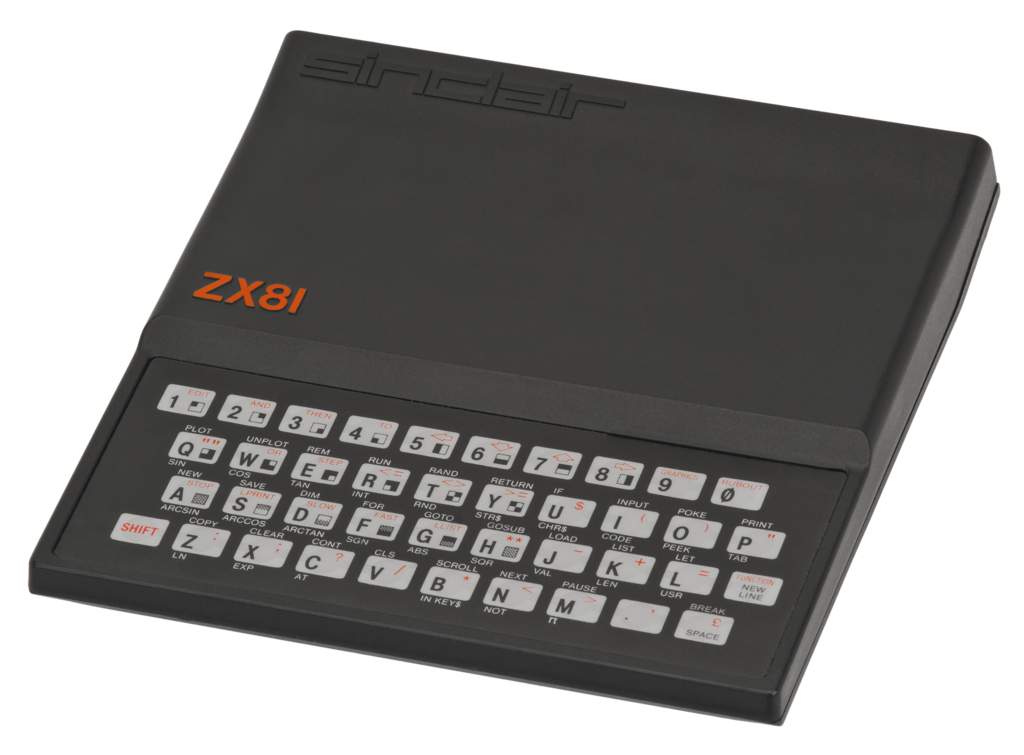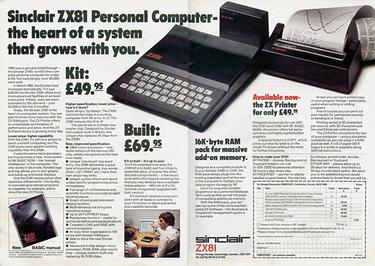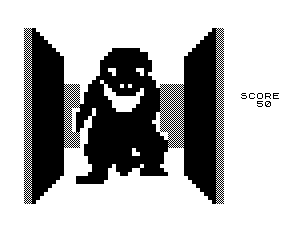Back In Black
The Sinclair ZX81 was launched in 1981 as the successor to the Sinclair ZX80. Like the ZX80, the ZX81 was available either as a kit or ready-made. Containing the same Z80 CPU (central processing unit) as the ZX80, 8K ROM (read-only memory) and 1K RAM (random access memory), it was cheaper than the ZX80 (£69.95 ready-made in the UK) due to a more efficient circuit design that used just 4 silicon chips compared with the ZX80’s 21.

The ZX81 addressed a number of the ZX80’s issues:
- its black wedge-shaped case is considered a design classic and avoided the ZX80’s tendency for the corners to snap off
- it added a “slow” mode that solved the ZX80’s problem of having the screen go blank every time a key was pressed
- it introduced floating-point arithmetic to the BASIC language (ZX80 users could buy an upgrade ROM and keyboard template to give them access to the new language features)
Like the ZX80, the ZX81 kept the membrane-style keyboard and, because of the slightly smaller computer size, the keys themselves were also smaller making typing tricky for those with large hands. An additional challenge was that the improved BASIC not only included additional floating-point operations (SIN, COS etc.) but also added numerous other functions. These new keywords had to be mapped to the existing keys which in turn meant that some keys had 5 different behaviours depending on context.

Sinclair released additional peripherals in the shape of a 16K RAM Pack and the ZX Printer although both had their flaws. The 16K RAM Pack had a tendency to fall out of its socket which caused the computer to reset and lose all unsaved work. The ZX Printer used black paper covered in a thin layer of aluminium – this layer was burnt away by a spark between the printer’s styluses exposing the black underneath. Unfortunately these tended to clog up with the aluminium residue causing the already limited print quality to drop even further.
Art For Art’s Sake, Money For God’s Sake
Unlike the ZX80 manual which featured a photo of the computer on the cover, the ZX81 manual had a specially commissioned painting by science-fiction artist John Harris. This sparked the imagination of many although the colour and detail was a stark contrast with the reality of the monochrome block graphics the ZX81 was actually capable of.

Despite the graphical limitations, a number of classic games were ported to the ZX81 including Space Invaders, Pac Man, Donkey Kong and even a chess game that fitted in 1K. Many new games were developed for the computer including Flight Simulation by Psion (who later moved into hardware with their Psion organizer range) and 3D Monster Maze, the first home computer game in 3D.
The ZX81 was also the first home computer to be sold on the high street in the UK with W.H Smiths selling 350,000 units in the first year. Over 1.5 million units were sold worldwide and that figure excludes unofficial clones that appeared in various markets. It continued to sell well, even after the arrival of its successor, the Sinclair ZX Spectrum.